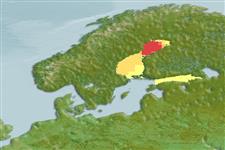Classification / Names
Common names from other countries
Main reference
Size / Weight / Age
Max length : 48.0 cm TL male/unsexed; (Ref. 556); common length : 20.0 cm TL male/unsexed; (Ref. 556); max. published weight: 1.0 kg (Ref. 556); max. reported age: 10 years (Ref. 593)
Environment
Marine; freshwater; brackish; benthopelagic; anadromous (Ref. 51243); depth range 30 - ? m
Climate / Range
Temperate, preferred 9°C (Ref. 107945); 71°N - 69°N, 2°W - 61°E
Distribution
Europe: Baltic basin, lakes of upper Volga drainage (Seliger, Vseluga, Perejaslavskoe), some lakes of White sea basin and North Sea basin east of Elbe drainage. Anadromous in Gulf of Finland and marine in northernmost freshened part of Gulf of Bothnia; north to about 69° N in Lake Inari, northern Finland; lower Rhine (now extirpated). Frequently stocked in lakes and reservoirs in Germany and Poland. Appendix III of the Bern Convention (protected fauna).
Countries | FAO areas | Ecosystems | Occurrences | Introductions
Short description
IUCN Red List Status (Ref. 115185)
Threat to humans
Harmless
Human uses
Fisheries: commercial; aquaculture: experimental
Tools
Special reports
Download XML
Internet sources
Estimates of some properties based on models
Phylogenetic diversity index
PD50 = 0.5000 many relatives (e.g. carps) 0.5 - 2.0 few relatives (e.g. lungfishes)
Trophic Level
3.1 ±0.17 se; Based on food items.
Resilience
Medium, minimum population doubling time 1.4 - 4.4 years (K=0.3-0.7; tm=2; tmax=10; Fec=2,000)
Vulnerability
Low to moderate vulnerability (27 of 100)
Price category
